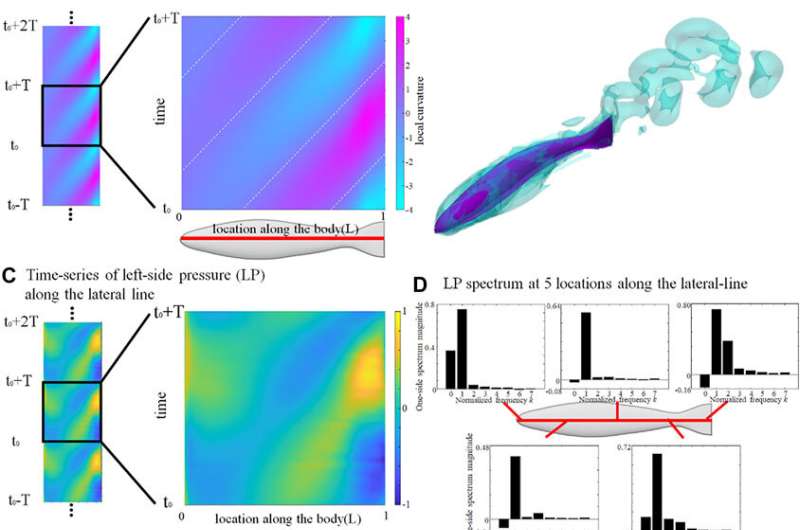Deformation and lateral-line stress in solely swimming fish. (A) curvature map of fish axis in an arbitrary tail-beat cycle (from t0 to t0+T); (B) Flow field surrounding a solely swimming fish; (C) pressure-stress map of the left-side lateral-line; (D) Frequency domain analysis of pressure stress signal at five locations along the lateral-line; (E) Distribution of single-sided spectrum of left-side pressure, at k = 0, 1, and 2; (F) shear-stress map of the left-side lateral-line; (G) Frequency domain analysis of shear-stress signal at five locations along the lateral-line; (H) Distribution of single-sided spectrum of left-side shear-stress signal, at k = 0, 1, and 2. One stress unit = 10 Pa. Credit: Frontiers in Robotics and AI (2022). DOI: 10.3389/frobt.2022.825889
Skoltech researchers and their colleagues from ESPCI Paris, Chiba University, and Japan Agency for Marine-Earth Science and Technology have used a 3D simulation to show that small fish swimming in a school can sense the position and tail beat of their neighbors as water pressure variation on the side of their bodies. This mechanism is thought to enable fish to maximize swimming efficiency in a group even in complete darkness, when no visual cues are available. Understanding group motion of fish is useful for predicting their migration and designing aquatic research robots that mimic fish behavior either for the energy-saving benefits of moving in a group or to blend in with the ocean creatures they are studying. The paper is published in Frontiers in Robotics and AI.
Prior research suggests fish swimming in groups may benefit from adopting optimal relative positions and synchronizing their movements. To keep track of neighbors even in dark or turbid environments, fish must clearly rely on more than just vision. "In this study, we simulate two rummy nose tetra fish swimming adjacently in various configurations in calm waters. We investigate the pressure signals propagating through water from one fish's body to the other's. While we don't know how the animals process them, the simulation shows that signals reaching the tactile sense organs are intelligible against the background noise and carry information about the neighbor's position and tail movement," commented study co-author Dmitry Kolomenskiy, an assistant professor at the Skoltech Center for Materials Technologies.
According to Kolomenskiy, further research might consider noisier environments, expand to larger groups of fish, and enlist artificial intelligence to look at how fish might process such signals. A prior study on ant swirling and bird flocks, also carried out at Skoltech, demonstrated the potential of AI for understanding the neural processes underlying the collective motion of animals.
In fact, there is an emerging trend in robotics that will increasingly see modular designs of smaller robots working in groups, or swarms. For example, a study in the upcoming May issue of Acta Astronautica will consider an eight-wheel Mars rover that can operate as a constellation of two-wheeled machines, maximizing exploration time.
Similarly, swarms of robotic fish equipped with pressure sensors might exploit the hydrodynamic advantages of moving in a group to replace larger underwater drones that explore historic shipwrecks—such as that of the recently discovered Ernest Shackleton's Endurance—or observe fish behavior. In the latter case, the added bonus is that studies have shown fish to be much less disturbed by sea probes that look and feel more fishlike.
Knowledge of how much energy ingested as food fish conserve by optimizing their movement in groups is also important for predicting their migration patterns, which is of use to the fishing industry.
More information: Gen Li et al, Hydrodynamical Fingerprint of a Neighbour in a Fish Lateral Line, Frontiers in Robotics and AI (2022). DOI: 10.3389/frobt.2022.825889
Journal information: Acta Astronautica
Provided by Skolkovo Institute of Science and Technology
























